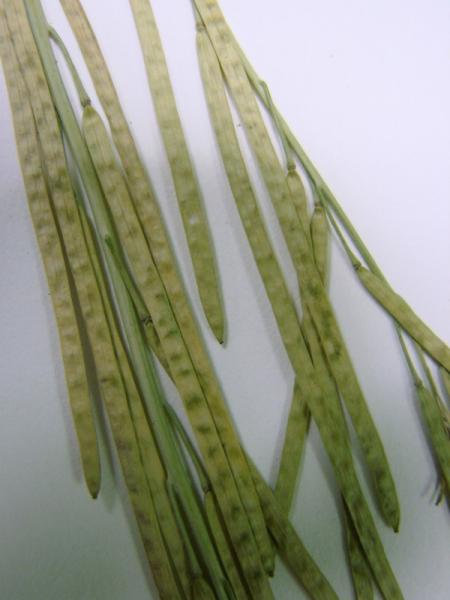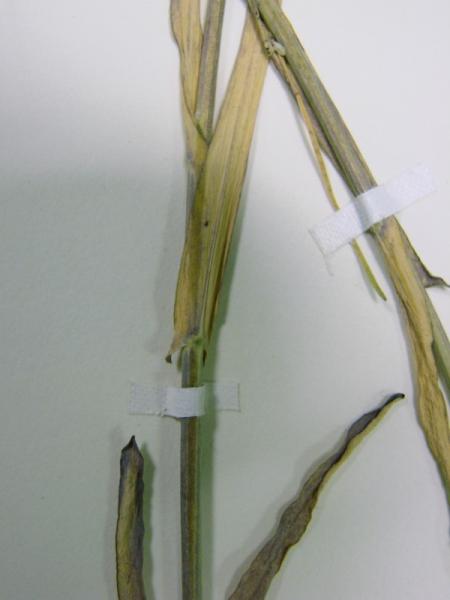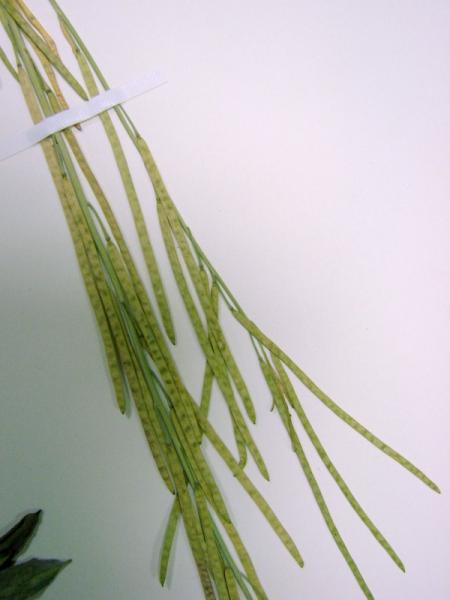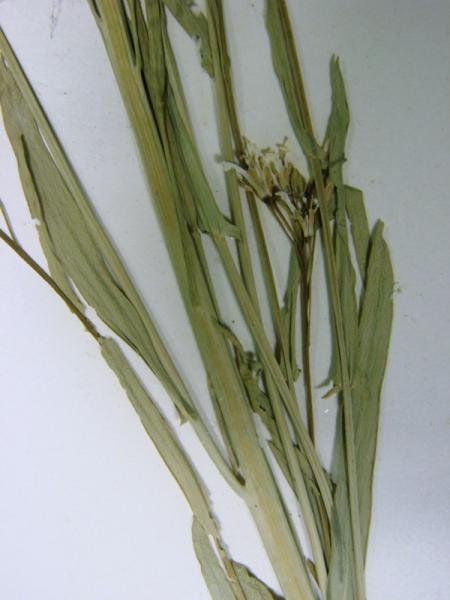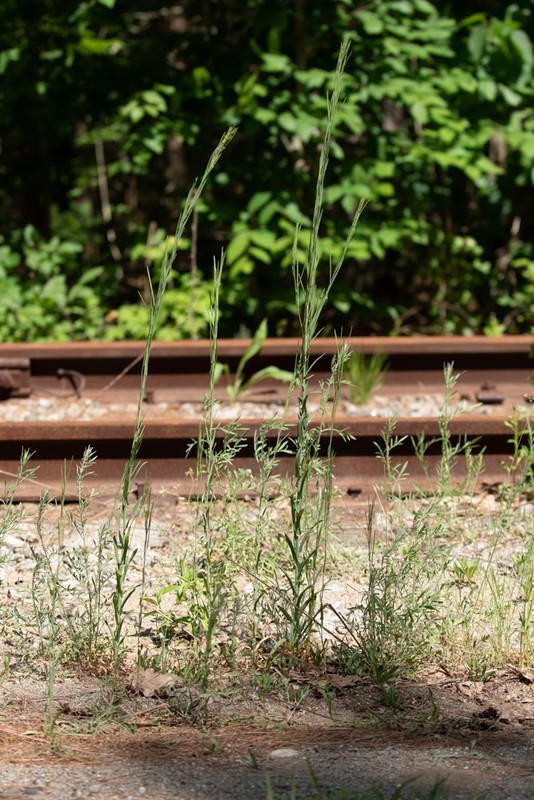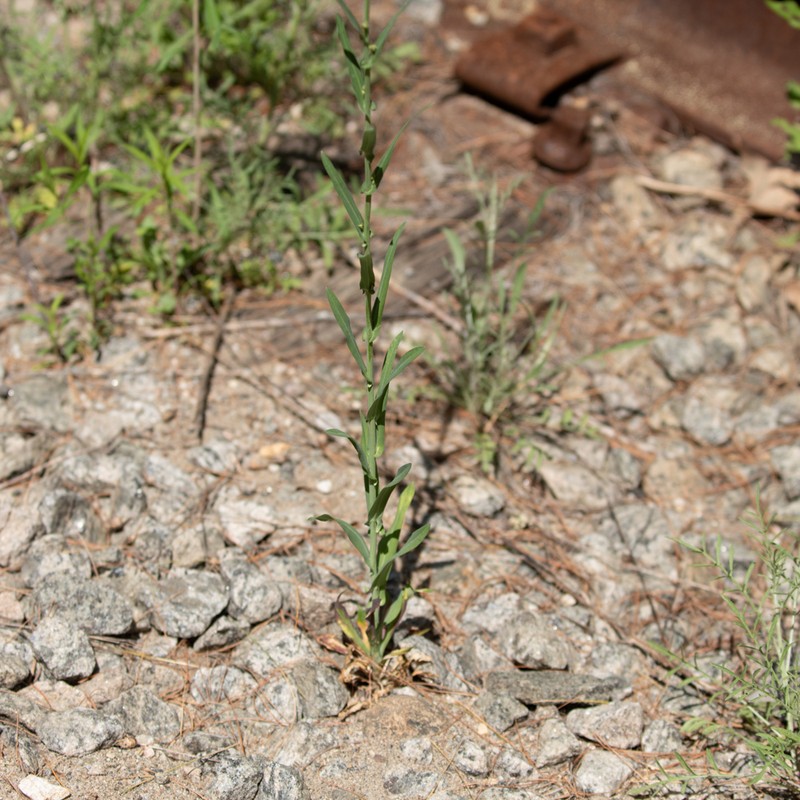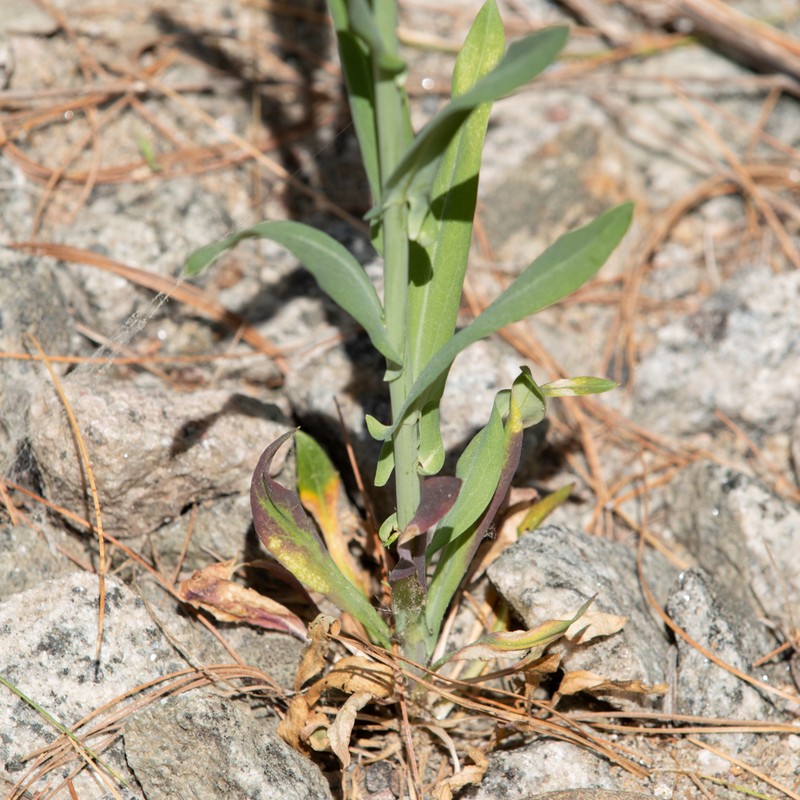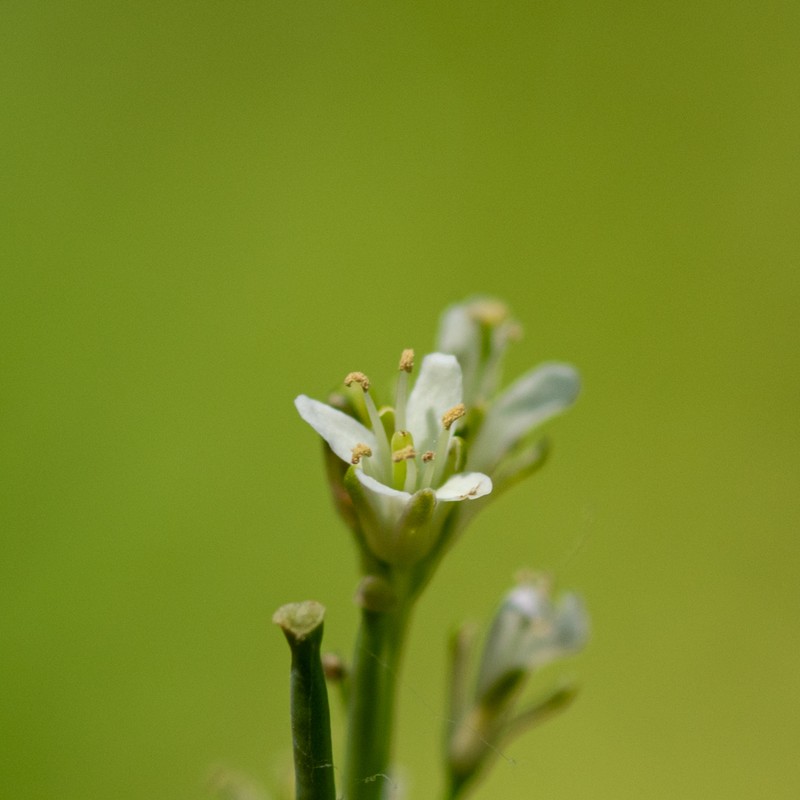Drummond's Rock Cress
Boechera stricta (Graham) Al-Shehbaz
- Class
- Dicotyledoneae (Dicots)
- Family
- Brassicaceae (Mustard Family)
- State Protection
- Threatened
Listed as Threatened by New York State: likely to become Endangered in the foreseeable future. For animals, taking, importation, transportation, or possession is prohibited, except under license or permit. For plants, removal or damage without the consent of the landowner is prohibited.
- Federal Protection
- Not Listed
- State Conservation Status Rank
- S2
Imperiled in New York - Very vulnerable to disappearing from New York due to rarity or other factors; typically 6 to 20 populations or locations in New York, very few individuals, very restricted range, few remaining acres (or miles of stream), and/or steep declines.
- Global Conservation Status Rank
- GNR
Not Ranked - Global conservation status not yet assessed.
Summary
Did you know?
This is the only species of Boechera in North America that has pick-shaped hairs on the lower stem. Even though it is an obvious biennial in our area, there are certain locations in the mountains of the West where the plants are definitely perennial. The common name refers to its former scientific name, "Arabis drummondii", after Thomas Drummond, an early 19th century Scottish botanist who explored the Rocky Mountains and southern U.S. "Boechera", the new genus name, is after the Danish botanist Tyge W. Bocher.
State Ranking Justification
There are 11 current populations but most of them have fewer than 100 plants each. There are more than 30 historical populations, so more occurrences are expected to be found.
Short-term Trends
The short-term trend seems stable but only a few occurrences have been revisited in recent years. Population sizes fluctuate, so more years of survey are needed to accurately determine short-term trend.
Long-term Trends
There were over 30 historical populations known throughout the state, but only 10 populations are currently documented. The long-term trend seems to indicate a decline, but more surveys of historical records may discover that this trend is not severe.
Conservation and Management
Threats
Probably the highest threat to the species is succession where the plants grow in human-disturbed areas the site is allowed to succeed to the woody plants that were there originally. The threat seems low in naturally open rock outcrops and sandy areas.
Conservation Strategies and Management Practices
In human-disturbed areas the disturbance may need to be maintained to prevent succession, while still taking care to prevent the destruction of the plants themselves.
Research Needs
Research into the specific habitat requirements of this species would help steer surveys to the most likely areas where it would be found.
Habitat
Habitat
In New York this species has been collected most often from rocky ledges, cliffs, or ravines, though it also has been found at disturbed sites including trails, mowed areas, and sandy roadsides (New York Natural Heritage Program 2007). Basic or circumneutral ledges, gravels and thickets (Fernald 1970). Various habitats (Gleason & Cronquist 1991).
Associated Ecological Communities
- Calcareous cliff community*
(guide)
A community that occurs on vertical exposures of resistant, calcareous bedrock (such as limestone or dolomite) or consolidated material; these cliffs often include ledges and small areas of talus.
- Shale cliff and talus community*
(guide)
A community that occurs on nearly vertical exposures of shale bedrock and includes ledges and small areas of talus. Talus areas are composed of small fragments that are unstable and steeply sloping; the unstable nature of the shale results in uneven slopes and many rock crevices.
- Shale talus slope woodland*
(guide)
An open to closed canopy woodland that occurs on talus slopes composed of shale. These slopes are rather unstable, and they are usually very well-drained, so the soils are shallow and dry. The canopy cover is usually less than 50%, due to the instability of the substrate.
* probable association but not confirmed.
Associated Species
- Abies balsamea (balsam fir)
- Acer negundo
- Acer pensylvanicum (striped maple)
- Acer rubrum
- Acer spicatum (mountain maple)
- Actaea rubra (red baneberry)
- Alliaria petiolata (garlic mustard)
- Alnus sp.
- Aralia nudicaulis (wild sarsaparilla)
- Arisaema triphyllum
- Athyrium filix-femina
- Betula cordifolia (mountain paper birch)
- Betula papyrifera (paper birch)
- Campanula rotundifolia (hare-bell)
- Carex brunnescens (brownish sedge)
- Carex lucorum (long-beaked carpet sedge)
- Centaurea stoebe
- Clintonia borealis (blue bead-lily)
- Danthonia spicata (poverty grass)
- Deschampsia flexuosa
- Diervilla lonicera (bush-honeysuckle)
- Draba arabisans (rock whitlow-grass)
- Dryopteris intermedia (evergreen wood fern, fancy wood fern, common wood fern)
- Dryopteris marginalis (marginal wood fern)
- Fagus grandifolia (American beech)
- Galium sp.
- Geum macrophyllum
- Gnaphalium obtusifolium
- Ionactis linariifolius
- Lonicera sp.
- Maianthemum canadense (Canada mayflower)
- Phegopteris connectilis (long beech fern)
- Picea rubens (red spruce)
- Pinus strobus (white pine)
- Poa glauca
- Poa pratensis
- Polygonatum pubescens (hairy Solomon's-seal)
- Polypodium appalachianum (Appalachian rock polypody, Appalachian polypody)
- Polypodium virginianum (Virginian rock polypody, Virginian polypody)
- Polytrichum sp.
- Quercus rubra (northern red oak)
- Ribes sp.
- Rubus occidentalis (black raspberry)
- Sambucus racemosa (red elderberry)
- Saxifraga virginiensis
- Sibbaldiopsis tridentata
- Sorbus americana (American mountain-ash)
- Spiraea alba
- Thalictrum dioicum (early meadow-rue)
- Thalictrum pubescens (tall meadow-rue)
- Thelypteris noveboracensis (New York fern)
- Tiarella cordifolia (foamflower)
- Tilia americana
- Toxicodendron radicans
- Trillium sp.
- Vitis sp
- Woodsia sp.
- Zizia aurea (common golden Alexanders)
Range
New York State Distribution
Boechera stricta has been found in scattered locations from most regions of the state.
Global Distribution
Boechera stricta is widely distributed in Canada and the western U.S., and found also in the Upper Midwest, New York, and New England, to as far south as Indiana, Ohio, New Jersey, and Delaware.
Identification Comments
General Description
Drummond's rock-cress is a tap-rooted biennial herb. Like other Boechera species, it has a compact rosette of basal leaves, the lowest of these spoon-shaped with toothed margins and the remainder lyrate (fiddle-shaped) - pinnatifid and pubescent. From this base grows a single stalk, smooth and often glaucous, 15 to 30 cm tall, bearing both leaves and flowers. The leaves of the stem have clasping lobes (auricles) at the base, and are 2 to 8 cm long, and the flowers have 4 small (less than 1 cm long) white petals. These mature into slender elongate fruit called siliques, which are 4-7 cm long, flat, held erect or appressed against the stem, and each holding two rows of seeds.
Best Life Stage for Proper Identification
Specimens with flowers or with mature fruit, or preferably, both, are best for identification.
Similar Species
Turritis (formerly Arabis) glabra has slightly longer but narrower round fruit (5-9 cm long by 0.8-1.3 mm wide) and the stem commonly has simple or star-shaped hairs, especially towards the base. Boechera divaricarpa has fruit that are not strongly ascending or appressed to the stem, but rather tend to be loosely ascending to divergent, and its basal leaves have fine star-shaped hairs on both sides. Before the distinct flattened fruit of Boechera stricta develop, it may also resemble B. laevigata, which has longer, less numerous leaves (5-15 cm long, averaging 13 below the first flower), and sepals that are more than half as long as the petals.
Best Time to See
Drummond's Rock-cress flowers in May, and the fruits persist until late August.
- Flowering
- Fruiting
The time of year you would expect to find Drummond's Rock Cress flowering and fruiting in New York.
Drummond's Rock Cress Images
Taxonomy
Drummond's Rock Cress
Boechera stricta (Graham) Al-Shehbaz
- Kingdom Plantae
- Phylum Anthophyta
- Class Dicotyledoneae
(Dicots)
- Order Capparales
- Family Brassicaceae (Mustard Family)
- Order Capparales
- Class Dicotyledoneae
(Dicots)
- Phylum Anthophyta
Synonyms
- Arabis drummondii Gray
- Boechera drummondii (A. Gray) Á. Löve & D. Löve [Name incorrectly applied.]
Additional Resources
References
Clemants, Steven and Carol Gracie. 2006. Wildflowers in the Field and Forest. A Field Guide to the Northeastern United States. Oxford University Press, New York, NY. 445 pp.
Fernald, M.L. 1950. Gray's manual of botany. 8th edition. D. Van Nostrand, New York. 1632 pp.
Gabel, J. D. and D. H. Les. 2000. Neobeckia aquatica (Greene): North American Lake Cress. New England Plant Conservation Program, Conservation and Research Plan. Prepared for: New England Wild Flower Society, 180 Hemenway Road, Framingham, MA.
Gleason, Henry A. and A. Cronquist. 1991. Manual of Vascular Plants of Northeastern United States and Adjacent Canada. The New York Botanical Garden, Bronx, New York. 910 pp.
Holmgren, Noel. 1998. The Illustrated Companion to Gleason and Cronquist's Manual. Illustrations of the Vascular Plants of Northeastern United States and Adjacent Canada. The New York Botanical Garden, Bronx, New York.
New York Natural Heritage Program. 2010. Biotics database. New York Natural Heritage Program. New York State Department of Environmental Conservation. Albany, NY.
New York Natural Heritage Program. 2024. New York Natural Heritage Program Databases. Albany, NY.
Reschke, Carol. 1990. Ecological communities of New York State. New York Natural Heritage Program, New York State Department of Environmental Conservation. Latham, NY. 96 pp. plus xi.
Voss, E.G. 1985. Michigan Flora. Part II. Dicots (Saururaceae - Cornaceae). Cranbrook Institute of Science and University of Michigan Herbarium. Ann Arbor, Michigan. 724 pp.
Weldy, T. and D. Werier. 2010. New York flora atlas. [S.M. Landry, K.N. Campbell, and L.D. Mabe (original application development), Florida Center for Community Design and Research http://www.fccdr.usf.edu/. University of South Florida http://www.usf.edu/]. New York Flora Association http://newyork.plantatlas.usf.edu/, Albany, New York
Weldy, Troy W. and David Werier. 2005. New York Flora Atlas. [S.M. Landry, K.N. Campbell, and L.D. Mabe (original application development), Florida Center for Community Design and Research. University of South Florida]. New York Flora Association, Albany, NY. Available on the web at (http://newyork.plantatlas.usf.edu/).
Links
About This Guide
Information for this guide was last updated on: October 25, 2022
Please cite this page as:
New York Natural Heritage Program. 2024.
Online Conservation Guide for
Boechera stricta.
Available from: https://guides.nynhp.org/drummonds-rock-cress/.
Accessed July 26, 2024.
